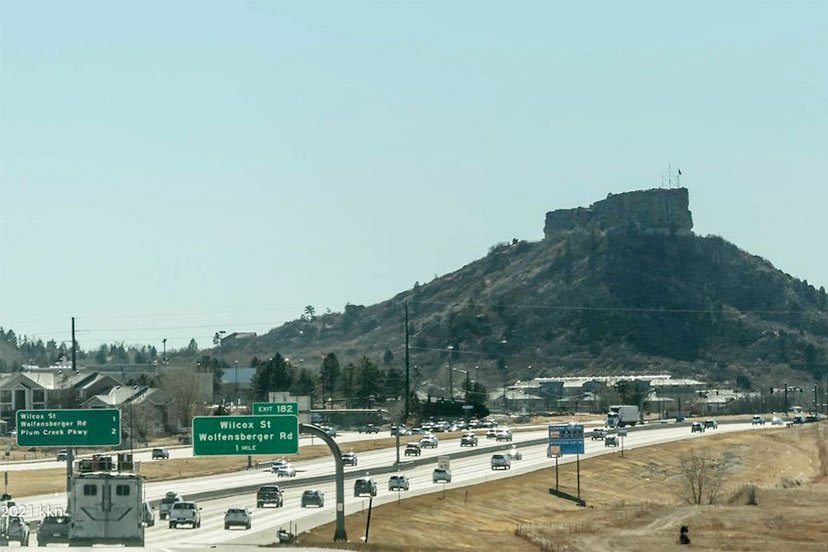PHOTO: Castle Rock, Colorado. Source: Flickr/Kari Nousiainen.
This story by Ben Abramson appeared on StrongTowns.org on February 22, 2023.
“A billion here, a billion there, and pretty soon you’re talking real money.”
This famous quote, attributed to the late Illinois senator Everett Dirksen, was meant to convey how casually Congress treats the federal budget. Now it apparently also applies to development and transportation funding in just one corner of Colorado.
The town council in Castle Rock, on the fringes of suburban Denver, received a shocking briefing from a finance official at a recent meeting. Its local taxing districts “have a combined debt of $943 million as of 2021,” reports the Colorado Sun. This has generated hundreds of millions of dollars just to service that amount, as “48% of the $943 million debt is accrued interest.”
So how did one region of one mid-sized state accrue almost a billion dollars of debt? The culprit is special taxing districts, sometimes called Community Development Districts (CDDs), or in Colorado, metro districts. But more broadly, it’s about how the nation’s commitment to the financially fragile suburban development pattern requires increasingly convoluted vehicles to keep it going.
In Castle Rock as elsewhere in Colorado, the metro district is granted power to sell bonds to build roads, sewer lines, and other infrastructure needed to build housing. The district is then given special taxing power over homeowners in the district to recoup its up-front investment. In the best-case scenario, the ensuing housing boom would lead to an increased tax base and local economy that would enable towns to thrive with a growing population.
But that’s not what’s happened here. Instead, local jurisdictions are left competing with a taxing entity that has to pay off hundreds of millions of dollars in interest on its struggling investment.
Or worse: “A Denver Post investigation into the inner workings of the state’s 1,800 metro districts found a governmental system that operates without the usual oversight of voters, without the usual restrictions on conflicts of interest, and without the usual checks and balances to ensure communities won’t spiral into insolvency.”
The paper found several examples of irresponsible management, broken promises, and cases of double dealing. In some places, the debt accrued by the special district exceeds the combined total value of all the homes built there. This could trigger a never-ending cycle of taxation with no hope of ever reaching solvency (like, say, a Ponzi scheme).
The Post spotlights one such case. In a district called Thompson Crossing, “homeowners’ property taxes haven’t been enough to repay bonds the district sold 13 years ago to build its infrastructure — the sidewalks, sewers, streets, and water lines. A refinancing plan has sunk the community deeper into debt, forcing some homeowners to try and sell their way out.”
Writing about this issue in 2020, when the pandemic slump called some of the country’s rosy real estate predictions into question, Strong Towns’ Daniel Herriges noted that “CDDs encourage reckless suburban overbuilding during boom times, because they make it possible to finance infrastructure at breathtaking scales.”
For Colorado, the combined debt of the state’s special metro districts ($19 billion) exceeds the debt accrued by the entire state government for all other purposes ($17 billion as of 2019). In the traditional development pattern, this would occur incrementally, using municipal financing when the proposed growth was viable.
Many of the 73,000 residents of Castle Rock have to pay taxes to both the town and the metro district, in some instances regardless of whether their property value has ascended in a year. For the town (despite its size, Colorado nomenclature calls Castle Rock a town), this structure substantially hampers its ability to generate revenue for other needs. Castle Rock metro districts collected a total of $32 million in 2021, compared to $1.4 million generated by the town’s real estate taxes.
This also points to a consumer challenge for any buyer considering a house in a brand-new development, either in Colorado or elsewhere in the U.S. With no property tax history, there’s no way to spot any fluctuations or red flags that would indicate your house or community could suffer some of the levies that hit Colorado homeowners when their metro district raised rates.
“Just as you might research the viability of a condo’s financing to avoid any unexpected assessments, as a buyer you should pay attention to how your new development was funded. The special taxing district that enabled it could later become a crushing liability,” warns Herriges.

